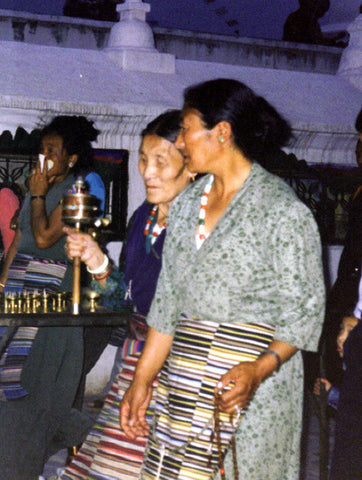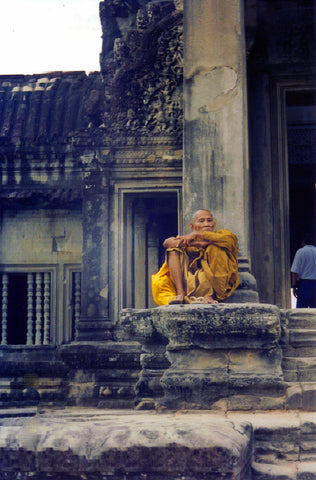Your Cart is Empty
Free Shipping for orders over $49 in Australia, $199 IN NEW ZEALAND/USA/CANADA AND $249 REST OF THE WORLD
Free Shipping for orders over $49 in Australia, $199 IN NEW ZEALAND/USA/CANADA AND $249 REST OF THE WORLD
Add description, images, menus and links to your mega menu
A column with no settings can be used as a spacer
Link to your collections, sales and even external links
Add up to five columns
Add description, images, menus and links to your mega menu
A column with no settings can be used as a spacer
Link to your collections, sales and even external links
Add up to five columns
Prayer Wheel
by Linda Heaphy May 04, 2017

Large prayer wheels at Swayambunath, Nepal.
Photo credit: Markus Koljonen (Dilaudid)
A prayer wheel is a Buddhist device consisting of a cylindrical wheel on a spindle, in which a scroll is placed with a mantra (prayer) written hundreds or sometimes thousands of times. The wheel is spun in a clockwise direction (based on the movement of the sun across the sky), allowing with each revolution the accumulation of as much merit as if each of the mantra inscriptions were read aloud separately. The more prayers a wheel holds, the more powerful it is considered to be. Turning the prayer wheels also assists to dissipate negative energy, or bad karma.
Traditionally, Tibetans and Nepalis use prayer wheels to accumulate merit and good karma for themselves, however any excess merit that an individual may gather during a session of use is freely given to all other sentient beings.

A prayer wheel in use by a Tibetan lady in the temple at Bodanath, Nepal.
Photo credit: Kashgar
A prayer wheel should be held almost upright and spun smoothly and slowly; greater benefit is achieved if its mantra is recited simultaneously as the wheel is turned. While concentrating on the mantra being recited while turning the prayer wheel has greater benefit and helps to focus the mind in a meditative state, it is believed by Buddhists that even an insect will gain merit for its next life by flying in the shadow of a prayer wheel, and simply touching a prayer wheel will assist to purify a negative karma.
The historical use of prayer wheels is poorly known. Wikipedia states that prayer wheels were first mentioned in written records around 400 C.E. by Chinese pilgrims inLadakh. A prayer wheel is the physical manifestation of the phrase "turning the wheel ofDharma," which describes the way in which theBuddha taught.
Different mantras to different buddhas, bodhisattvas and gods may be written upon prayer wheels. A very common mantra today is Om Mani Padme Hum, meaning Hail, Jewel in the Lotus. This is the mantra of the compassionate Buddha, Avalokitsvara, of whom the Dali Lama is an incarnation.

A standing prayer wheel. Photo credit: Kashgar
References and Further Reading
Khandro.net 1998 "All about the ... Prayer Wheel". Accessed 4 May 2017
Wikipedia. Prayer Wheel. Accessed 4 May 2017

A small hand held prayer wheel for personal use. Photo credit: Kashgar
Leave a comment
Comments will be approved before showing up.
Also in Symbols & Ritual Objects

Om Mani Padme Hum – the Mantra of Compassion
by Linda Heaphy July 03, 2017
Beliefs And Customs Buddhism Eight Auspicious Symbols Nepal Om Prayer wheel Religion Spirituality Symbology Tibet
Read More Articles
About the Author
- Linda has a Honours degree in Marine Biology and a PhD in Ecology from the University of NSW, Australia. She has travelled extensively and is a passionate writer on subjects as diverse as the role played by women throughout history, tribal communities and their customs, symbology and ethnology, talismans and their history. Occasionally she also writes about her travel experiences, her new life on a 25 acres in the Northern Rivers region of northern Australia and her black miniature poodle Phoenix. She is currently writing her first book on talismans.
About Us
-
The Kashgar Philosophy

Kashgar began through a love of travel.
In 1989 my father Bernard packed in his house painting business and set off for two years on a backpacking trek to the remotest corners of the world. When he finally arrived in the oasis city of Kashgar, China, he was so impressed with its history that he decided to start a new life collecting and selling exotic goods from all over the world. For 2000 years the legendary city of Kashgar was a melting pot of ideas and a key trading post on the historic Silk Road. It was this unique combination of philosophy and trade that my father wanted to recreate at home.
Starting in markets in 1991, he opened his first store in the Sydney suburb of Newtown in 1994. I gave up my own career as a government scientist to join him in 2000 and soon convinced my partner Ian to join us in what was to become the Family Business.
Today our version of Kashgar stocks a hugely diverse range of furniture, rugs, textiles, antiques, handicrafts and jewellery sourced from over twenty different countries including India, Nepal, Tibet, China, Thailand, Burma, Laos, the Philippines, Vietnam, Mexico, Peru, Turkey, Palestine, Syria, Afghanistan and Turkmenistan. Our collection includes contemporary and tribal silver and gold jewellery, a unique range of headhunting curios, antique Buddhist relics and a collection of one-off necklaces, earrings and bracelets that I design and create myself using the beads and jewellery making techniques of ethnic minorities from around the globe.
Kashgar is a philosophy as well as a store. We are committed to supporting traditional artisans and small village communities by selling authentic handcrafted goods which are personally collected by us. By supporting traditional methods of design and production we hope to encourage local cottage industries which have a low impact on the environment and help ethnic minorities maintain their self-sufficiency into the 21st Century. We are particularly committed to assisting women around the world and to this end have worked with several organisations including the Hua Bin Women's Union of Vietnam, the East Timorese Women's Association and Tikondane in Zambia. Time honoured means of craftsmanship and traditional ways of life are disappearing as people all over the world give up their identity in favour of jeans and T-shirts. We see our trade as a means of staving off the inevitable encroachment of the 21st century, assisting communities to decide for themselves which parts of the western world they wish to incorporate (medicine, education) and which they wish to reject (prostitution, drug production, begging and servitude to warlords). We encourage our customers to think of the handicrafts and artifacts they buy from us as an investment: a piece of history and a way of life that may soon be gone forever.
Kashgar has recently closed its retail outlet and gone completely online.
In the past our pieces appeared in many movies including The Hobbit, Mission Impossible 2, Queen of the Damned, Scooby Doo, Moulin Rouge and Wolverine, and in many televisions series, as well as in plays, commercials and exhibitions. We've found special pieces for individual customers as well as for film sets, event management companies, hotels, businesses, consulates and embassies. The uniqueness of our stock means that we are also very appealing to interior and fashion designers with a taste for the exotic.
There is something for everyone at Kashgar - collectors, the curious, those looking for a special present or for something unique to adorn the home. Most of our items are one-off specialties; other pieces we only stock in small quantities so as to continuously offer a wide and ever-changing range of interesting products. We are also packed with ideas for decorating home and work premises that will challenge your established concepts of design and storage.

Please enjoy - Linda Heaphy
Become a Kashgar nomad and join our mailing list...
Sign up to get the latest on sales, new releases and more …




